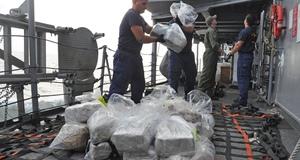|
Featured Article: Mexican Drug Activity, Economic Development, and Unemployment in a Rational Choice Framework
The scope of the research sample encompasses cities in northern Mexico with a significant “Big Four” drug cartel presence, to include the Monterrey Metropolitan Region in Nuevo Leon, Ciudad Juarez in Chihuahua, Nogales in Sonora, and Nuevo Laredo in Coahuila. According to Manwaring, all four cities have seen a precipitous increase in cartel-related violence over the past two decades and have served as primary drug corridors into the United States. In addition, each city has gone through a period of accelerated urbanization, with large numbers of rural occupants migrating to the cities to take advantage of economic opportunities (2007). According to the 2010 Mexican Census, Monterrey has a population of approximately 1,130,960 people, Ciudad Juarez has a population of 1,321,004, Nogales has a population of 212,533, and Nuevo Laredo has a population of 373,725 (INEGI-M, 2012). Four Southern U.S. cities were also chosen based on their relative population size, proximity to the border, and history as nexus points for drug traffickers. The selected cities include Phoenix, Arizona (population: 1,445,632), Tucson, Arizona (population: 520,116), El Paso, Texas (population: 649,121), and Laredo, Texas (population: 236,091) (US Census Bureau, 2012).
Consistent with Widner et al.’s collection methods, GDP per capita, official unemployment rates, annual homicide totals, and drug arrests for Monterrey, Ciudad Juarez, Nogales, and Nuevo Laredo were provided by the Instituto Nacional De Estadistica Y Geografia Mexicana (INEGI-M) or the Mexican National Institute of Statistics and Geography. Much like the U.S. Census Bureau, the INEGI releases annual reports that track national, state and municipal socioeconomic indicators. As the country’s primary information repository, the INEGI also provides criminal justice statistics, to include reported crimes and arrests by different law enforcement agencies.
Unlike Mexico, statistical information concerning the four US border cities was gathered from a number of different official sources. Municipal drug arrest data was gathered from the Bureau of Justice Statistics, while municipal homicide statistics was collected utilizing the Federal Bureau of Investigation’s annual Uniform Crime Report (UCR). Per capita GDP was found at the Department of Commerce’s Bureau of Economic Analysis and unemployment figures were obtained from the Department of Labor’s Bureau of Labor Statistics. As a time series study, independent and dependent variable data was collected to capture the period from 2000 to 2010. Raw data for the independent and dependent variables can be found in the Appendix.
The primary quantitative method is a trend analysis that compares the independent and dependent variables over the sampled time period. Specific relationships between the independent and dependent variables were analyzed utilizing a bivariate linear regression analysis characterized by the function Y= β0+ β1X + ε. The analysis was conducted utilizing the Excel 2010 Analytic Tool Package.
With the variables defined and the method of analysis selected, the following hypotheses can be stated:
Hypothesis 1. As annual gross domestic product per capita in each municipality decreases, the number of drug arrests and homicides will increase in both US and Mexican cities.
Hypothesis 2. As the unemployment rate increases in each municipality, the number of drug arrests and homicides will increase as well.
Hypothesis 3. The GPD per capita will maintain an inverse relationship with the dependent variables, such that an increased GPD per capita will predict lower drug arrests and homicides in US and Mexican cities over the sampled time period.
Hypothesis 4. The unemployment rate will maintain a strong positive relationship with the dependent variables, such that decreased unemployment will predict lower drug arrests and homicides in US and Mexican cities over the sampled time period.
During the project conceptualization and data collection phase, a number of limitations and deficiencies were identified. Limitations were divided into data collection and operationalization concerns and uncontrolled third variable phenomena. It was understood early on that these issues could potentially affect the strength and significance of correlation coefficients in each of the regression models.
Data Collection & Operationalization: As referenced previously, there are fundamental problems when comparing and contrasting cross-cultural data. Each independent and dependent variable has its own operational definition that can hinder the comparison of US and Mexican statistics. Early on, it was understood that official unemployment statistics in the United States differed from unemployment statistics gathered in Mexico. In the United States, someone is characterized as unemployed if “they do not have a job, have actively looked for work in the prior 4 weeks, and are currently available for work.” The unemployment rate is the “number of unemployed as a percent of the labor force.” Participation in part-time employment or temporary jobs is not counted in the official statistics (Bureau of Labor Statistics, 2013). This is in stark contrast to the unemployment definition utilized by the INEGI, which includes employment in marginal jobs, part-time positions, and even unpaid jobs. According to Widner et al., the INEGI even counts individuals who engage in one hour per week of work as “gainfully employed.” This helps to explain the artificially low Mexican municipal unemployment rates during the darkest days of the global economic recession.
There were numerous issues identified with the dependent variables as well. Though the author was eventually able to locate official municipal homicide statistics for both the United States and Mexico, these homicides represent aggregate totals in each city and not “drug-related” murders directly related to counterdrug efforts or organized crime-related turf battles. The FBI’s Uniform Crime Report and the Mexican INEGI do not differentiate between homicides stemming from interpersonal violence and those related to third-party adversarial actions. Given the quality of the information provided and the fact that individual municipalities voluntarily provide this information to federal authorities, it is difficult to rule out the influence of a third variable or directly infer that an increase in homicides is related to drug activity. Though alternate unofficial sources exist, to include the University of San Diego’s Trans-Border Institute (TBI), the statistics are often limited in scope and data collection methods are questionable; statistics are gathered from third party sources like newspapers and media outlets that are prone to sensationalizing drug murders. Even if unofficial statistics are available, the data may only encompass a two or three year period, which is not sufficient for the current study. Drug arrest statistics were no better. Though the UCR clearly compartmented drug violations into two categories, simple possession or possession with intent to distribute, the INEGI provided aggregate statistics generically referenced as “en materia de narcoticos” or “narcotics matters.” A closer look at the operational definition shows that that the term applies to a relatively large range of different drug offenses, from simple possession, to production and refinement activities, to drug and precursor smuggling.
In addition to the quality of the data collected, there was a general lack of data available on the Mexican side of the border that necessitated the occasional calculation of predictive statistics. For example, municipal homicide totals were missing for Nuevo Laredo in 2002, 2004 and 2005. Utilizing available state and municipal statistics, an average percent representation was derived and used to calculate homicide totals for the years where data was unavailable (see Table 6 in Appendix for calculation). While statistical modeling was utilized when possible, some data was unavailable during critical years and could not be inferred using calculations. Drug arrest statistics were unavailable for each of the sampled Mexican cities in 2009 and 2010. Given increased tempo of counterdrug operations by the Calderon Administration in concert with the relaxation of simple possession violations referenced by Lacey (2009), it was not feasible to produce predictive statistics that could potentially affect the results of the statistical analysis. These years were ultimately omitted from the regression analysis.
Third Variable Phenomena: When initially glancing at the data sets, it is clear that other third variables exist that could potentially affect the outcome of an empirical analysis. Many of the Mexican cities considered to be the “frontline” of the drug war experienced an enormous influx of reported murders from the mid to late 2000’s. While some of the increases are due to improved reporting and record keeping on the behalf of local governments and security services, many of the homicides are attributed to the influx of soldiers into areas traditionally controlled by DTO’s and organized crime. Consistent with Manwaring’s analysis, recent violence can be characterized as a struggle between the legitimate government and the self-serving institutions created by the cartels that have been allowed to operate with relative impunity over the last few decades. In cities like Ciudad Juarez, homicides skyrocketed from 401 in 2007 to 1,372 in 2008. Though less dramatic, Nogales experienced a similar increase in homicides, with 78 recorded in 2007 to 138 recorded in 2008 (see Table 6 in Appendix). With homicides doubling and tripling during the same year that President Calderon ordered 20,000 troops into many of these border cities, it is difficult to attribute an increase in homicides solely to disparate economic conditions (Seper, 2011).Continued on Next Page »
Acharya, A.K. (2011). Urban Violence in Northern Border of Mexico: A Study from Nuevo Leon State. Sociology Mind, 1 (4). 177-182.
Arsovska, J. & Kostakos, P.A. (2008). Illicit arms trafficking and the limits of rational choice theory: the case of the Balkans. Trends in Organized Crime, 11 (4). 352-378.
Baron, S.W. (2007). Street Youth, Gender, Financial Strain, and Crime: Exploring Broidy and Agnew’s Extension to General Strain Theory. Deviant Behavior, 28(1): 273-302.
Burdett, K., Lagos, R., & Wright, R. (2004). An On-the-Job Search Model of Crime, Inequality and Unemployment. International Economic Review, 45(3): 681-706.
Bureau of Labor Statistics (2013). Labor Force Statistics from the Current Population Survey. Retrieved from http://www.bls.gov/cps/lfcharacteristics.htm#unemp.
Collom, L. & Newton, C. (2008). Crime falls in Phoenix; police credit new tactics. The Arizona Republic. Retrieved from http://www.azcentral.com/news/articles/0229phxcrime 0229.html?&wired.
Fox, S. & Hoelscher, K. (2010). The Political Economy of Violence: Theory and Evidence from a Cross-Country Study. Crisis States Working Papers, 72(2). London, UK: LSE DESTIN.
Gould, E.D., Weinberg, B.A., & Mustard, D.A. (2002). Crime Rates and Local LaborOpportunities in the United States: 1979-1997. The Review of Economics and Statistics, 84(1): 45-61.
Killebrew, R. (2011). Criminal Insurgency in the Americas and Beyond. PRISM Security Studies Journal, 2 (3): 33-52.
Knickerbocker, B. (2006). Illegal Immigrants in the US: How many are there? The Christian Science Monitor. Retrieved from http://www.csmonitor.com /2006/0516/p01s02-ussc.html.
Lacey, M. (2009). In Mexico, Ambivalence on a Law. The New York Times. Retrieved from http://www.nytimes.com/2009/08/24/world/americas/24mexico.html? pagewanted=all.
Manwaring, M.G. (2007). A Contemporary Challenge to State Sovereignty: Gangs and other Illicit Transnational Criminal Organizations in Central America, El Salvador, Mexico, Jamaica and Brazil. Security Studies Institute of the US Army War College. Washington, DC: US Government Printing Office.
Martin, G. (2000). Employment and Unemployment in Mexico in the 1990’s. Monthly Labor Review, 123 (11): 3-18.
Phillips, J. & Land, K.C. (2012). The link between unemployment and crime rate fluctuations: An analysis at the county, state, and national levels. Social Science Research, 41(1): 681-694.
Raphael, S. & Winter-Ebmer, R. (2001). Identifying the Effect of Unemployment on Crime. U. of Chicago Journal of Law and Economics, 44: 259-281.
Scherlen, R.G. (2012). US Evaluation of Mexican Drug War Efforts: Short-Termed and Short-Sighted. The Latin Americanist, 56(2). 35-61.
Scherlen, R.G. (2009). The Colombianization of Mexico? The Evolving Mexican Drug War (1st ed.). New Orleans: Southern Political Science Association.
Seper, J. (2011, April 20). Los Zetas Spread Message of Fear; Violent Mexican Drug Cartel Establishing Footholds in the U.S. The Washington Times. Page A01.
Shirk, D.A. (2010). Drug Violence in Mexico: Data and Analysis from 2001-2009. Trends in Organized Crime, 13: 167-174.
Truman, E.M. (1996). The Mexican Peso Crisis: Implications for International Finance. Federal Reserve Bulletin. Retrieved from http://www.federalreserve.gov /pubs/bulletin/1996/396lead.pdf.
US Overseas Loans & Grants (2013). United States Agency for International Development. Retrieved from http://gbk.eads.usaidallnet.gov/.
United States Joint Forces Command (2008). The Joint Operating Environment 2008. Washington, DC: Government Print Office.
Vest, M.J. (2010). The recovery is stronger than appreciated. Arizona’s Economy. Retrieved from http://azeconomy.eller.arizona.edu/azeconomyissues/AEFall10.pdf.
Vest, M.J. (2008). Still looking for the bottom. Arizona’s Economy. Retrieved from http://azeconomy.eller.arizona.edu/azeconomyissues/AEFall08.pdf.
Villarreal, M.A. (2010). NAFTA and the Mexican Economy (CRS Report #7-5700). Retrieved from http://www.fas.org/sgp/crs/row/RL34733.pdf.
Widner, B., Reyes-Loya, M.L. & Enomoto, C.E. (2011). Crimes and Violence in Mexico: Evidence from Panel Data. The Social Science Journal, 48: 604-611.
Wilkinson, T. (2009). Mexico drug traffickers corrupt politics. LA Times. Retrieved from http://www.latimes.com/news/nationworld/world/la-fg-michoacan-drugs31-2009may31,0,3065365,full.story.
Wright, R.F. (2010). Mexican Drug Violence and Adversarial Experiments. North Carolina Journal of International Law and Commercial Regulation, 35(2): 363-385.
Appendix
Table 5: Arrests for drug-related offenses by municipality in Mexico from 2000 – 2010.
| |
|
|
2000
|
2001
|
2002
|
2003
|
2004
|
2005
|
2006
|
2007
|
2008
|
2009
|
2010
|
|
Ciudad Juarez
|
3029
|
2727
|
2717
|
2886
|
2587
|
2851
|
2824
|
2595
|
936
|
*
|
*
|
|
Monterrey
|
2226
|
2525
|
2713
|
2642
|
2109
|
1709
|
1448
|
1529
|
1438
|
*
|
*
|
|
Nogales
|
|
610
|
625
|
447
|
460
|
608
|
592
|
615
|
743
|
862
|
*
|
*
|
|
Nuevo Laredo
|
491
|
437
|
314
|
310
|
1190
|
1458
|
1305
|
1398
|
1381
|
*
|
*
|
Statistics gathered from the Instituto Nacional de Estadística y Geografía (INEGI) at www.inegi.org.mx. Per the INEGI, drug arrests are listed under the blanket arrest “en material de narcoticos,” which includes a large number of different drugs offenses, including but not limited to illicit drug consumption, possession with intent to distribute narcotics, and drug smuggling activities. * = Statistics unavailable for the listed year.
Table 6: Municipal homicides of sampled Mexican cities from 2000 – 2010.
| |
|
|
2000
|
2001
|
2002
|
2003
|
2004
|
2005
|
2006
|
2007
|
2008
|
2009
|
2010
|
|
Ciudad Juarez
|
385
|
371
|
399
|
318
|
338
|
320
|
315
|
401
|
1372
|
2000
|
2545
|
|
Monterrey
|
497
|
568
|
533
|
524
|
510
|
619
|
658
|
784
|
732
|
704
|
1287
|
|
Nogales
|
|
31
|
52
|
32
|
42
|
43
|
60
|
58
|
78
|
138
|
174
|
226
|
|
Nuevo Laredo
|
115
|
71
|
79*
|
106
|
97*
|
154*
|
199
|
116
|
119
|
119
|
155
|
Municipal statistics gathered from the Instituto Nacional de Estadística y Geografía (INEGI) at www.inegi.org.mx. State-level statistics were gathered from the Transborder Institute at http://justiceinmexico.org/data-portal/2480-2/. For the missing years, a percent representation was derived by dividing the municipal homicides by state level homicides. The percentages were averaged together to calculate an average percent representation. The average percent was multiplied by state level statistics for the years where data is unavailable to generate a predictive statistic. * = Homicide statistics were unavailable for the listed year.
Formula
City 2000 / State 2000 + City 2001 / State 2001 + City 2003 / State 2003 + City 2006 / State 2006 + City 2007 / State 2007 + City 2008 / State 2008 + City 2009 / State 2009 + City 2010 / State 2010 = Average Percent Representation (APR)
APR x State Homicides = Number of Homicides for No Year Data
Table 7: Gross Domestic Product (GDP) per capita of sampled Mexican cities from 2000 – 2010.
| |
|
|
2000
|
2001
|
2002
|
2003
|
2004
|
2005
|
2006
|
2007
|
2008
|
2009
|
2010
|
|
Ciudad Juarez
|
1330
|
1294
|
1434
|
1560
|
1656
|
1796
|
2250
|
2174
|
2507
|
2782
|
715*
|
|
Monterrey
|
1541
|
1704
|
2118
|
2207
|
3356
|
2955
|
3476
|
3078
|
3516
|
3253
|
3272
|
|
Nogales
|
|
1464
|
1455
|
1562
|
1706
|
1864
|
1712
|
1963
|
2820
|
3376
|
2916
|
3077
|
|
Nuevo Laredo
|
***
|
4524
|
3656
|
4460
|
5349
|
3514
|
4177
|
5096
|
6248
|
8832
|
6581
|
Statistics gathered from the Instituto Nacional de Estadística y Geografía (INEGI) at www.inegi.org.mx. GDP is measured in Mexican pesos. * = Based on partial-year data; *** = Data unavailable for that year.
Table 8: Unemployment rates of sampled Mexican cities from 2000 – 2010.
| |
|
|
2000
|
2001
|
2002
|
2003
|
2004
|
2005
|
2006
|
2007
|
2008
|
2009
|
2010
|
|
Ciudad Juarez
|
1.7
|
2.6
|
4.2
|
3.8
|
1.8
|
2.1
|
2.7
|
2.6
|
4.2
|
7.2
|
5.4
|
|
Monterrey
|
2.9
|
2.9
|
4.4
|
4.3
|
5.7
|
4.7
|
4.7
|
4.5
|
4.3
|
7.2
|
4.3
|
|
Nogales
|
|
2.7
|
3.9
|
6.7
|
5.8
|
5.4
|
3.4
|
2.9
|
2.9
|
4
|
5.6
|
5.6
|
|
Nuevo Laredo
|
2.7
|
3.1
|
3.6
|
3.2
|
4.7
|
4.1
|
4
|
4.1
|
4.5
|
6.4
|
4.8
|
Statistics gathered from the Instituto Nacional de Estadística y Geografía (INEGI) at www.inegi.org.mx. This data represents the statistical average over a twelve month reporting period.
Table 9: Annual drug arrest totals of sampled US cities from 2000 – 2010.
| |
|
|
2000
|
2001
|
2002
|
2003
|
2004
|
2005
|
2006
|
2007
|
2008
|
2009
|
2010
|
|
Phoenix
|
Sale & Distribution
|
2,100
|
2,053
|
2,421
|
2,623
|
1,929
|
1,218
|
1,678
|
1,399
|
1,258
|
1,281
|
1,242
|
| |
Possession
|
3,736
|
3,453
|
3,268
|
3,615
|
5,147
|
5,763
|
5,053
|
5,546
|
5,113
|
5,266
|
4,467
|
| |
Total
|
|
5,836
|
5,506
|
5,689
|
6,238
|
7,076
|
6,981
|
6,731
|
6,945
|
6,371
|
6,547
|
5,709
|
| |
|
|
|
|
|
|
|
|
|
|
|
|
|
|
Tucson
|
Sale & Distribution
|
576
|
648
|
678
|
674
|
803
|
826
|
708
|
853
|
869
|
973
|
753
|
| |
Possession
|
5,597
|
5,599
|
5,730
|
6,132
|
6,555
|
7,018
|
6,365
|
5,970
|
5,681
|
6,474
|
5,774
|
| |
Total
|
|
6,173
|
6,247
|
6,408
|
6,806
|
7,358
|
7,844
|
7,073
|
6,823
|
6,550
|
7,447
|
6,527
|
| |
|
|
|
|
|
|
|
|
|
|
|
|
|
|
El Paso
|
Sale & Distribution
|
149
|
74
|
17
|
94
|
28
|
109
|
183
|
109
|
180
|
195
|
263
|
| |
Possession
|
3,355
|
3,862
|
3,398
|
3,516
|
3,364
|
2,930
|
2,685
|
3,902
|
4,561
|
4,473
|
4,028
|
| |
Total
|
|
3,504
|
3,936
|
3,415
|
3,610
|
3,392
|
3,039
|
2,868
|
4,011
|
4,741
|
4,668
|
4,291
|
| |
|
|
|
|
|
|
|
|
|
|
|
|
|
|
Laredo
|
Sale & Distribution
|
*
|
4
|
2
|
*
|
*
|
*
|
*
|
*
|
3
|
12
|
13
|
| |
Possession
|
797
|
769
|
742
|
752
|
871
|
833
|
1,002
|
1,031
|
864
|
1,029
|
928
|
| |
Total
|
|
797
|
773
|
744
|
752
|
871
|
833
|
1,002
|
1,031
|
867
|
1,041
|
941
|
Data obtained from the Bureau of Justice Statistics. Statistics gathered through the Arrest Analysis Tool found at http://bjs.ojp.usdoj.gov/index.cfm?ty=datool&surl=/arrests/index.cfm#. This data represents total arrest tallies recorded by major municipal police departments in each city. Statistics are voluntarily provided by each department annually. The statistics have been subdivided into two categories: arrests for the sale or manufacturing of illicit substances and arrests for the possession substances for personal use. Drug violation totals in each of the four cities have been captured. * = Denotes a lack of available statistics in that given year.
Table 10: Municipal homicides of sampled US cities from 2000 – 2010.
| |
|
2000
|
2001
|
2002
|
2003
|
2004
|
2005
|
2006
|
2007
|
2008
|
2009
|
2010
|
|
Phoenix
|
|
152
|
209
|
177
|
241
|
202
|
220
|
235
|
212
|
167
|
122
|
116
|
|
Tucson
|
|
60
|
42
|
47
|
47
|
55
|
55
|
51
|
49
|
65
|
35
|
51
|
|
El Paso (SD)
|
5
|
4
|
3
|
0
|
6
|
4
|
8
|
3
|
2
|
4
|
2
|
|
El Paso (PD)
|
20
|
20
|
14
|
21
|
11
|
14
|
13
|
17
|
17
|
12
|
5
|
|
El Paso (Total)
|
25
|
24
|
17
|
21
|
17
|
18
|
21
|
20
|
19
|
16
|
7
|
|
Laredo
|
|
10
|
8
|
7
|
29
|
15
|
18
|
22
|
10
|
10
|
17
|
9
|
Data obtained from the Federal Bureau of Investigation, Uniform Crime Report. Statistics gathered through the UCR Table Building tool found at http://www.ucrdatatool.gov/. This data represents homicide totals recorded by major municipal police departments in each city. Statistics are voluntarily provided by each department annually. * = Individual homicide statistics are collected and distributed to the FBI by the El Paso County Sheriff's Department and the El Paso City Police Department. Statistics are listed separately (SD for Sheriff's Department and PD for the City Police Department) and together (SD and PD added to represent the total number of homicides).
Table 11: Gross Domestic Product (GDP) per capita of sampled US cities from 2000 – 2010.
| |
|
2000
|
2001
|
2002
|
2003
|
2004
|
2005
|
2006
|
2007
|
2008
|
2009
|
2010
|
|
Phoenix
|
|
41050
|
41107
|
41264
|
42494
|
43006
|
44658
|
46290
|
46112
|
44499
|
40182
|
40375
|
|
Tucson
|
|
29240
|
29222
|
28326
|
29508
|
29589
|
30605
|
31365
|
31975
|
31442
|
28870
|
28387
|
|
El Paso
|
|
29500
|
29535
|
30272
|
30062
|
29846
|
30029
|
30854
|
30505
|
30323
|
28984
|
29759
|
|
Laredo
|
|
22050
|
22119
|
22559
|
22558
|
22266
|
22521
|
22295
|
22188
|
22920
|
20991
|
21440
|
Data obtained from the US Department of Commerce, Bureau of Economic Analysis. Statistics gathered through the BEA's Interactive Data Service tool at http://www.bea.gov/itable/. This data represents the statistical average over a twelve month reporting period. GDP is measured in US dollars.
Table 12: Unemployment rates of sampled US cities from 2000 – 2010.
| |
|
2000
|
2001
|
2002
|
2003
|
2004
|
2005
|
2006
|
2007
|
2008
|
2009
|
2010
|
|
Phoenix
|
|
3.3
|
4.2
|
5.6
|
5.2
|
4.5
|
4.1
|
3.6
|
3.2
|
5.3
|
9.3
|
9.8
|
|
Tucson
|
|
3.7
|
4.3
|
5.7
|
5.3
|
4.6
|
4.5
|
3.9
|
3.6
|
5.6
|
9
|
9.4
|
|
El Paso
|
|
6.8
|
7.3
|
8.2
|
8.8
|
7.6
|
7
|
6.7
|
5.9
|
6.3
|
8.8
|
9.8
|
|
Laredo
|
|
6.1
|
6.6
|
7.3
|
7.4
|
6.7
|
6
|
5.4
|
4.7
|
5.4
|
8.4
|
8.9
|
Data obtained from the US Department of Labor, Bureau of Labor Statistics. Statistics gathered through the BLS Tools application at http://data.bls.gov/cgi-bin/surveymost?la. This data represents the statistical average over a twelve month reporting period.
Save Citation » (Works with EndNote, ProCite, & Reference Manager)
APA 6th
Masucci, D. J. (2013). "Mexican Drug Activity, Economic Development, and Unemployment in a Rational Choice Framework." Inquiries Journal/Student Pulse, 5(09). Retrieved from http://www.inquiriesjournal.com/a?id=755
MLA
Masucci, David J. "Mexican Drug Activity, Economic Development, and Unemployment in a Rational Choice Framework." Inquiries Journal/Student Pulse 5.09 (2013). <http://www.inquiriesjournal.com/a?id=755>
Chicago 16th
Masucci, David J. 2013. Mexican Drug Activity, Economic Development, and Unemployment in a Rational Choice Framework. Inquiries Journal/Student Pulse 5 (09), http://www.inquiriesjournal.com/a?id=755
Harvard
MASUCCI, D. J. 2013. Mexican Drug Activity, Economic Development, and Unemployment in a Rational Choice Framework. Inquiries Journal/Student Pulse [Online], 5. Available: http://www.inquiriesjournal.com/a?id=755
Suggested Reading from Inquiries Journal
Both gangs and police in Rio de Janeiro seemingly operate irrationally in an extended conflict, as it is highly unlikely that the state will make drug dealing legal, and it is also unlikely that gangs would be able to destroy... MORE»
This paper analyzes the ongoing drug war being waged between Mexican drug trafficking organizations (DTOs), their rivals, and the U.S./Mexican governments. This analysis is conducted through the lens of drug control; namely, through an examination of the distinct strategies of interdiction and international operations. While both... MORE»
Recently, the state of the United States-Mexico border has assumed primary importance in American domestic politics. And with that, the border has been conflated with notions of security. This paper will investigate the root causes of the border's securitization by grounding the case study of the Camarena Affair within The Copenhagen... MORE»
The international drug trade and the power of drug cartels have perplexed both analysts and policy makers for years. As drug production and trade grow, cartels have climbed to unthinkable heights of power and, in some cases, have crippled governments. This study explores this problem and attempts to answer the predominant question... MORE»
Latest in Criminology & Criminal Justice
2019, Vol. 11 No. 01
While media coverage and politicians constantly acknowledge the inadequacies of the criminal justice system in managing victims and offenders of color and low socioeconomic status, the discussion about the failure of the criminal justice system... Read Article »
2018, Vol. 10 No. 01
This paper analyzes the ongoing drug war being waged between Mexican drug trafficking organizations (DTOs), their rivals, and the U.S./Mexican governments. This analysis is conducted through the lens of drug control; namely, through an examination... Read Article »
2011, Vol. 3 No. 01
The search for the criminal personality or super trait has captured both the minds and imaginations of academics and the wider community (Caspi et al., 1994). Partly, this is due to a stubborn aversion to the notion that normal, regular people rape... Read Article »
2015, Vol. 5 No. 1
Organized crime and terrorist organizations cannot be battled by force alone; anti-money laundering (AML) techniques have become key tools to trace these individuals through their finances. Every country has an interest in implementing internationally... Read Article »
2016, Vol. 6 No. 2
This paper explores the role of public institutions in reducing or fostering neighborhood violence and crime. Understanding institutional density as a neighborhood effect, this paper examines how ten public institutions and structures influence... Read Article »
2016, Vol. 8 No. 07
Heroin use and the consequences that come from it are skyrocketing around the United States. From major metropolitan areas to rural towns, millions of people are in the throes of opiate addiction. The traditional response to the illegal use and... Read Article »
2016, Vol. 3 No. 1
It is generally accepted among researchers that incidence of crime is on average higher around vacant and abandoned properties because they can serve as safe havens for criminal activity. However, there has been little research investigating the... Read Article »
|



















